
|
|

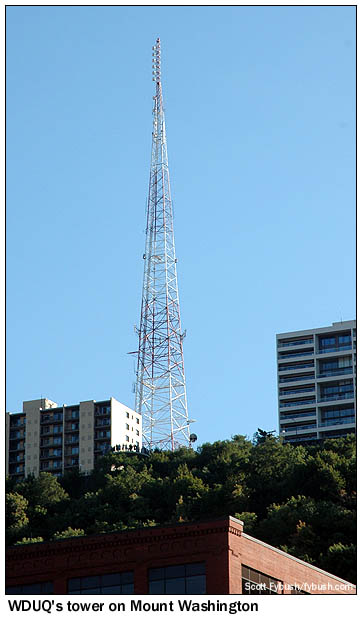 July
1, 2011
July
1, 2011
WDUQ, Pittsburgh
The last few weeks have brought some changes in the world of public radio and TV: in New Jersey, the NJN radio stations were split off to new owners (New York's WNYC and Philadelphia's WHYY) while NJN's TV network ended up in the hands of New York's WNET; in Orlando, PBS member station WMFE-TV is in the process of being sold to Daystar - and in Pittsburgh, Duquesne University is selling its public radio station, WDUQ (90.5), to a consortium called "Essential Public Media" that's made up of principals from Public Radio Capital and the local AAA station, WYEP (91.3).
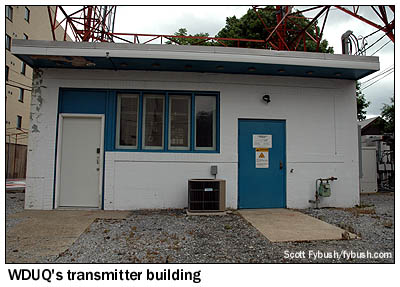
As luck would have it, we had planned our first visit to the Steel City (timed to coincide with the Red Sox/Pirates interleague series) for just a few days before the July 1 transfer of WDUQ to its new operators. Having never been inside the WDUQ transmitter building high atop Mount Washington on the south shore of the Monongahela River, the trip ended up providing us with a chance to see the facility in its last days under the old management - and to pay homage to WDUQ's long history of public service and technical excellence.
(Our tour guide this day is outgoing WDUQ chief engineer Chuck Leavens, a 22-year station veteran who's well-known in the public radio community for his stewardship of the PubTech mailing list.)
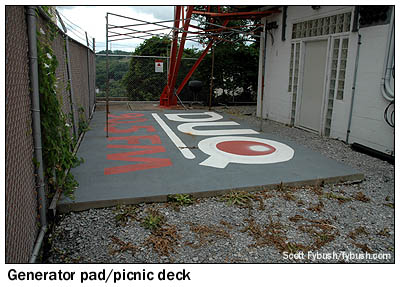 |
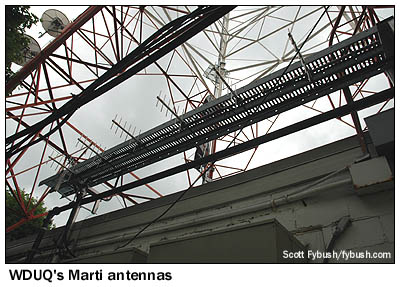 |
We begin our tour outside, where WDUQ's fenced-in transmitter building sits cheek-by-jowl with the tall apartment buildings that enjoy million-dollar views of the downtown Pittsburgh skyline just across the river. The building itself is on Shiloh Street, just half a block from Grandview Avenue, the scenic drive that runs along the top of Mount Washington past the scenic overlooks and the top of the only-in-Pittsburgh inclined railway that chugs up the hill from Station Square down below.
There's lots of history here: the building and 390-foot tower went up around 1948 for one of Pittsburgh's first commercial FM stations, KQV-FM. Originally on 98.1, the FM sister of KQV (1410) used this site to bolster its very directionally-challenged AM signal...and unlike some of the city's other early FMs, KQV-FM survived FM's dark days in the 1950s and stayed on the air long enough to experience the medium's revival in the 1960s.
By then KQV-FM had moved to 102.5, and around the time that it changed calls to WDVE in 1971, then-owner ABC moved the station to a higher-elevation site in the North Hills (the KDKA-TV tower, where it remains today) and donated the Mount Washington tower site to Duquesne University.
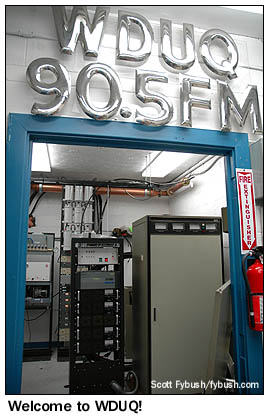 |
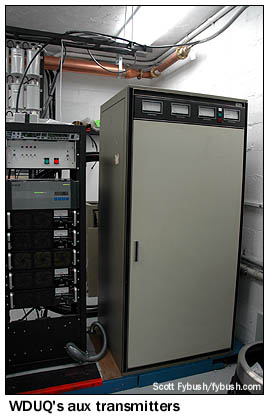 |
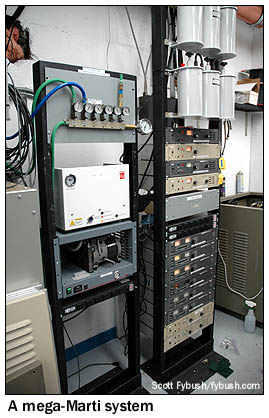 |
Duquesne was another Pittsburgh FM pioneer: it put WDUQ on the air in 1949 as the city's first educational FM signal, initially with 10 watts on 89.3, soon upgraded to 2750 watts on 91.5. That's where the station remained until it made its big move up here to Mount Washington in 1972, when it moved down the dial to its final home of 90.5 and increased its power to 25,000 watts. (The 91.5 frequency was soon reused by a new community station, WYEP, and who could then have guessed that little WYEP, eventually moved to 91.3, would itself end up operating WDUQ someday?)
The tower has been through several owners over the years: Duquesne eventually sold the site to the CSX railroad, and today it's owned by American Tower, which houses several other commercial tenants in a front room and in outdoor enclosures next to the building.
And with the history out of the way, we head inside, where we're greeted first by a small anteroom with a home-brew UPS system, a bathroom with its very own "ON AIR" light that goes on when the door is closed, and, above the door to the transmitter rooms, the shiny "WDUQ 90.5 FM" sign that once graced the station's studios on the Duquesne campus just across the river.
 |
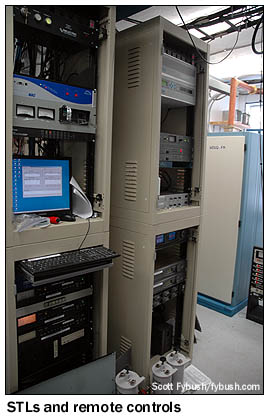 |
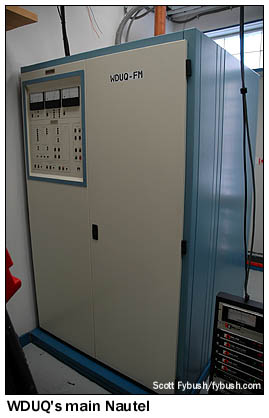 |
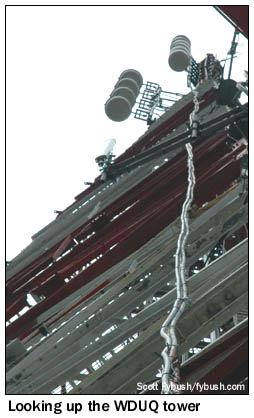 The
first transmitters we see through the door are WDUQ's auxiliary
units: the Elcom-Bauer that was the old main, and next to it
a backup exciter that can either feed the power amplifier in
the Elcom-Bauer or the stack of lower-powered amplifiers in the
rack below.
The
first transmitters we see through the door are WDUQ's auxiliary
units: the Elcom-Bauer that was the old main, and next to it
a backup exciter that can either feed the power amplifier in
the Elcom-Bauer or the stack of lower-powered amplifiers in the
rack below.
Behind it are two racks that house WDUQ's Marti system: six channels of remote program reception capability (using receive antennas high on the tower, with clear views to most of Pittsburgh) and retransmission capability (using the row of yagis on the roof) back to the studios. With this system in use, WDUQ never had to depend on cellphones or their predecessors to cover big events like election nights; instead, its news staffers could simply fire up their Marti transmitters and talk back and forth amongst themselves and back to the studios.
WDUQ's studio-transmitter links and remote controls (and the subcarrier modulators for the radio reading service the station operated) occupied two racks across from the auxiliary transmitter - and just beyond them, the other half of the transmitter room houses the 20 kW Nautel analog transmitter that went in here in 2005 and the HD Radio equipment that went on the air a year later.
It's a clean, carefully-thought-out transmitter facility, and it sounded great on the air, whether it was during WDUQ's drivetime NPR news blocks or the jazz music that filled the rest of the station's programming hours. And it was with no small amount of sadness that we tuned in June 30 to hear the last of that weekday jazz; under the new Essential Public Radio management, the jazz has been relegated to HD2 and a few weekend hours, replaced with fulltime NPR news and talk.
Even the WDUQ calls, by far the oldest set of FM calls in western Pennsylvania, will soon be history: once Duquesne completes its sale of the license later this year, the calls will change to something new as well.
We're sorry we never made it inside WDUQ's longtime studios in the Des Plaines Language Center on the Duquesne campus; that building met the wrecking ball last year, and the station had been operating from makeshift studios in a temporary facility on campus pending its move to WYEP's studios on Pittsburgh's South Side later this summer. But at least we can now say we saw the WDUQ transmitter site - and now you can, too. (And of course we'll have some IDs from WDUQ starting July 6 over at our sister site, TopHour.com.)
 - Find out when the new Tower Site is posted,
and much more! Follow us on Twitter @NERadioWatch - and don't miss your chance to order the all-new
Tower Site Calendar 2011, now on CLEARANCE at the Fybush.com store!
- Find out when the new Tower Site is posted,
and much more! Follow us on Twitter @NERadioWatch - and don't miss your chance to order the all-new
Tower Site Calendar 2011, now on CLEARANCE at the Fybush.com store!- Previous Site of the Week: Harrisburg, PA, 2009, part II
- Next Week: Mount Tom and WGGB/WGBY, Springfield, MA
- Site of the Week INDEX!
- How can you help support Site of the Week? Click here!
- Submit your suggestions for a future Site of the Week!

